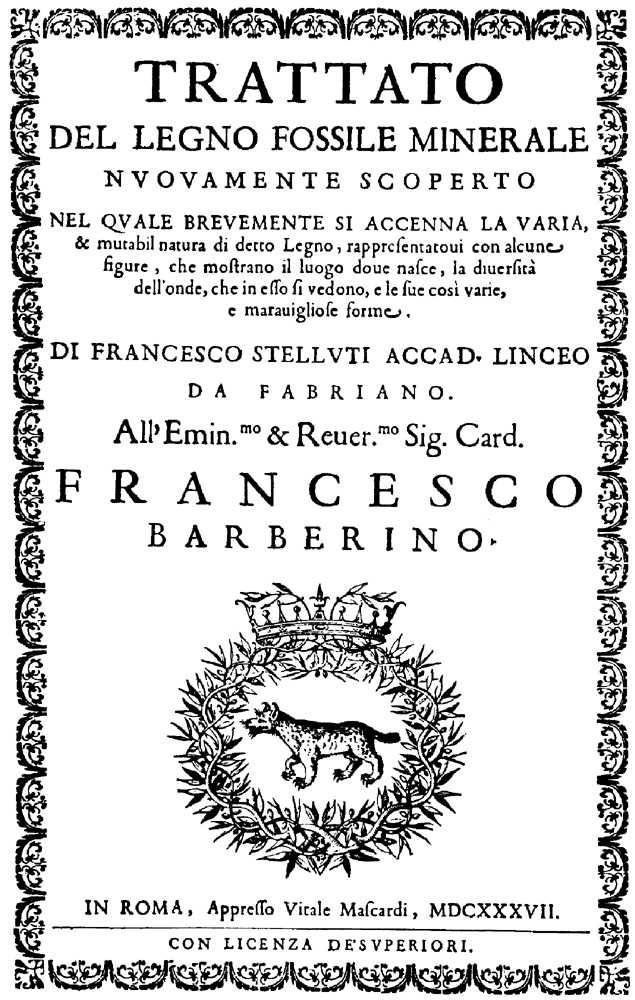STELLUTI, Francesco.
(1577 – 1646)
Stelluti was born to a patrician family of Fabriano, which intended that he study law. For this purpose he was sent to Rome towards the end of the sixteenth century. In Rome, Stelluti became friends with Federico Cesi and Johannes Eck, with whom they founded the Accademia dei Lincei in August 1603. His pseudonym at the academy was Tardigradus, and he took as his symbol the planet Saturn. In 1604 Stelluti was forced to retreat to his native Fabriano, due to increasing hostile attacks towards the secret brotherhood of the the Lincei. After a period of quiet, the Academy was revived, and Stelluti returned to Rome in 1608 or 1609.
After initially rejecting Galileo's Sidereus Nuncius (Rome, 1610), Stelluti was eventually won over by the theory, and a sustained correspondance began between the two. Their relationship grew to such a bond that Stelluti wrote introductory verses for Galileo's other works, Istoria e Dimostrazioni Intorno alle Macchie Solari (Rome, 16??) and Il Saggiatore (Rome, 16??). In 1625, Stelluti made the first microscopic observations to be published, perhaps with an insturment supplied by Galileo. The volume that appeared was titled, Persio Tradotto in Verso Sciolto (Rome, 1630), and shows in the illustrations various insects and their anatomy at different magnification.
Biographical references: ABI: II 599, 230. • DSB: 13, 29-30 [by A.G. Keller]. • Gabrieli, G., "Francesco Stelluti, Linceo Fabrianese", Atti della Reale Accademia Nazionale dei Lincei. Memorie della classe di scienze morali, storiche e filolgiche, 2, (1941), 191-233. • Gabrieli, G., "Il carteggio scientifico ed accademico fra i primi Lincei 1603-30", Atti della Reale Accademia Nazionale dei Lincei. Memorie della classe di scienze morali, storiche e filolgiche, 1, (1925), 137-219. • Poggendorff: 2, col. 1000. • Ramelli, C., "Discorso intorno a Francesco Stelluti da Fabriano", Giornale arcadico di scienze, lettere ed arte, 87, (1841), 106-44. • Singer, C., "The earliest figures of microscopic objects", Endeavour, 12, (1953), 197. • WBI. • World Who's Who in Science: 1604.

1. Latin, 1637.
[Contained within an ornately bordered box:] Trattato | Del Legno Fossile Minerale | Nvovamente Scoperto | Nel Qvale Brevemente Si Accenna La Varia, | & murabil natura di derro Legno, rappresentatoui con alcune | figure, che mostrano il luogo doue nasce, la diuersità | dell'onde, che in esso si vedono, e le sue così varie, | e marauigliose forme. | Di Francesco Stellvti Accad. Linceo | Da Fabriano. | All'Emin.mo & Reuer.mo Sig. Card. | Francesco | Barberino. | [ornament] | In Roma, Appresso Vitale Mascardi , MDCXXXVII. | [rule] | Con Licenza De'Svperiori.
2°: A6; 6l.; [1]-12 p., one folding map (double-page), 12 plates (one folding). Printer's device on page 12.
Contents: [1-2], Title page, verso blank.; 3-4, Dedication to Cardinale Francesco Barberino, signed Francesco Stelluti.; 5-12, Text.; [At end], One folding map (double-page), 12 plates (one folding).
Very rare. An account of the fossilized wood found in the region of Todi in central Italy. It is based upon Federico Cesi's theories of a class of "metallophytes" intermediate between metals and plants, and possessing properties of both. Stelluti explains how he had abandoned his own idea that these fossils were simply buried, mineralized tree trunks.
Bibliographical references: Brunet: 5, 530 ["Dissertation curieuse et rare."]. • LKG: XVI 290. • Ward & Carozzi, Geology Emerging, 1984: no. 2107.
.